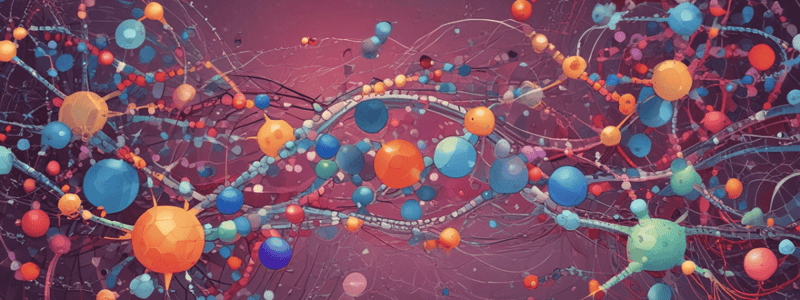Podcast
Questions and Answers
What is the primary consequence of mutations in DNA repair genes?
What is the primary consequence of mutations in DNA repair genes?
- Increased expression of tumor suppressor genes
- Decreased frequency of mutations in proto-oncogenes
- Increased frequency of mutations in proto-oncogenes and tumor suppressor genes (correct)
- Complete elimination of cancer cells
Which of the following is an example of a receptor tyrosine kinase involved in cancer?
Which of the following is an example of a receptor tyrosine kinase involved in cancer?
- HER1
- EGFR
- ERBB1 (correct)
- ALK
What is the effect of gene amplification on oncogenes?
What is the effect of gene amplification on oncogenes?
- Increased expression of oncogenes (correct)
- Decreased expression of oncogenes
- No effect on oncogenes
- Mutation of oncogenes
What type of genetic defect commonly affects tumor suppressor genes?
What type of genetic defect commonly affects tumor suppressor genes?
What is the mechanism by which some cancer cells stimulate their own proliferation?
What is the mechanism by which some cancer cells stimulate their own proliferation?
What is the primary function of DNA repair genes?
What is the primary function of DNA repair genes?
Which of the following genes is NOT a tumor suppressor gene?
Which of the following genes is NOT a tumor suppressor gene?
What is the name of the hypothesis that explains the occurrence of retinoblastoma?
What is the name of the hypothesis that explains the occurrence of retinoblastoma?
What is the result of loss of normal p53 function?
What is the result of loss of normal p53 function?
What is the role of the APC gene in colonic neoplasia?
What is the role of the APC gene in colonic neoplasia?
What is the primary function of the MYC proto-oncogene?
What is the primary function of the MYC proto-oncogene?
Which type of mutation is most commonly found in RAS family genes?
Which type of mutation is most commonly found in RAS family genes?
What is the function of the RB protein in tumor suppressor genes?
What is the function of the RB protein in tumor suppressor genes?
What is the result of RAS mutations in human tumors?
What is the result of RAS mutations in human tumors?
What is the effect of HER2 amplification and overexpression in breast cancers?
What is the effect of HER2 amplification and overexpression in breast cancers?
Flashcards are hidden until you start studying
Study Notes
Oncogenes and Cancer
- A deletion on chromosome 5 can fuse part of the ALK gene with part of another gene called EML4, creating a fusion gene in a subset of lung cancers.
- HER2 amplification and overexpression in breast cancers can be treated with antibodies or drugs that block HER2 activity, leading to cessation of tumor growth and tumor regression.
- RAS mutations are the most common type of abnormality involving proto-oncogenes in human tumors, occurring in 15-20% of cases.
- RAS genes (HRAS, KRAS, NRAS) are commonly activated by point mutations, trapping RAS in its active state and forcing the cell into a continuously proliferating state.
- Transcription factors like MYC can activate the transcription of other genes, and its amplification or translocation can contribute to cancer development.
Tumor Suppressor Genes
- Tumor suppressor genes apply brakes to cell proliferation, and their mutation can lead to uncontrolled cell growth.
- The Retinoblastoma (RB) gene regulates the G1/S checkpoint and is located on chromosome 13.
- Mutations in DNA repair genes can lead to an increase in mutations in other genes, including proto-oncogenes and tumor suppressor genes.
Molecular Defects in Cancer
- Gene amplification can increase the expression of oncogenes.
- Deletions can lead to the loss of tumor suppressor genes.
- Most human cancers have molecular defects that affect one or more components of growth factor signaling pathways.
Growth Factors and Receptors
- Normal cells require stimulation by growth factors to proliferate, but cancer cells can acquire the ability to synthesize their own growth factors, creating an autocrine loop.
- Oncogenes can encode growth factor receptors, such as receptor tyrosine kinases, which can be activated by point mutations, gene rearrangements, or gene amplifications.
- Examples of growth factor receptors involved in cancer include ERBB1 (EGFR) and ERBB2 (HER2).
Retinoblastoma and TP53
- Retinoblastoma is a childhood tumor that can occur sporadically or be inherited as an autosomal dominant trait.
- The two-hit hypothesis explains the development of retinoblastoma, requiring two mutations (hits) to inactivate both normal alleles of the RB locus.
- TP53, located on chromosome 17p, is a tumor suppressor gene that is mutated in over 70% of human cancers and plays a crucial role in DNA repair, cell division, and cell death by apoptosis.
Other Tumor Suppressor Genes
- APC (Adenomatous polyposis coli) is a tumor suppressor gene that functions by downregulating growth-promoting signaling pathways and is associated with familial adenomatous polyposis.
- APC loss of function can contribute to the development of colon cancer.
- DNA repair genes ensure accurate copying of genetic information during cell division, and their mutation can lead to an increase in cancer-causing mutations.
Studying That Suits You
Use AI to generate personalized quizzes and flashcards to suit your learning preferences.



